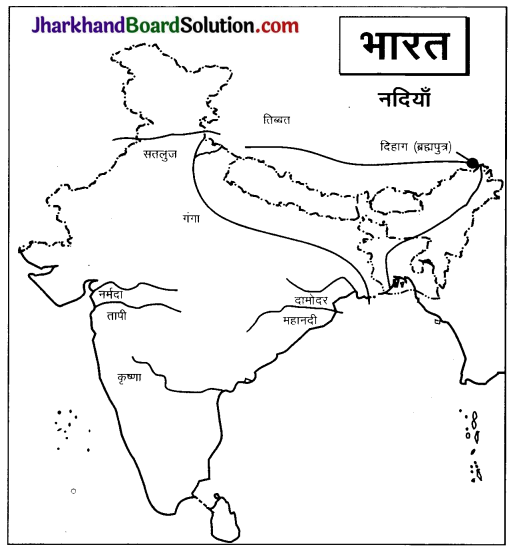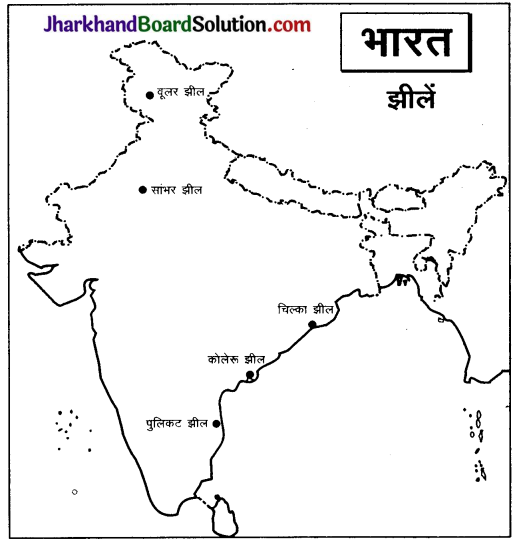JAC Board Class 9th Social Science Solutions Geography Chapter 4 जलवायु
JAC Class 9th Geography जलवायु InText Questions and Answers
प्रश्न 1.
राजस्थान में घरों की दीवार मोटी तथा छत चपटी क्यों होती हैं?
उत्तर:
राजस्थान का अधिकांश भाग मरुस्थलीय है, यहाँ की जलवायु अत्यन्त गर्म है, यहाँ वनस्पति के अभाव के कारण सूर्य की किरणें धरातल पर सीधी पड़ती हैं। यहाँ हवाएँ भी तीव्र गति से चलती हैं, यहाँ गर्मियों में तो धूल भरी आँधियाँ चलती हैं। राजस्थान में इन्हीं विषम परिस्थितियों के कारण यहाँ के निवासी अपने घरों की दीवार मोटी बनाते हैं ताकि वे देरी से गर्म हों।
इससे घर के अन्दर का तापमान कम रहता है एवं लम्बे समय तक ठंडक बनी रहती है। घरों की छतें चपटी बनायी जाती हैं क्योंकि यहाँ वर्षा कम होती है। इस प्रकार की छतों से वर्षा जल की एक-एक बूंद को एकत्रित किया जा सकता है। इसके अतिरिक्त ऐसी छतों का आँधियों में उड़ जाने का खतरा भी नहीं रहता है।

प्रश्न 2.
तराई क्षेत्र तथा गोवा एवं मैंगलोर में ढाल वाली छतें क्यों होती हैं?
उत्तर:
तराई क्षेत्र तथा गोवा एवं मैंगलोर भारत के ऐसे क्षेत्रों में स्थित हैं, जहाँ पर्याप्त मात्रा में वर्षा होती है। गोवा एवं मैंगलोर में 300-400 सेमी. से भी अधिक वर्षा एवं तराई क्षेत्रों में 100-200 सेमी तक वर्षा होती है इसलिए इन क्षेत्रों में ढलान वाली छतें बनाई जाती हैं ताकि पानी छतों पर रुके नहीं बल्कि ढलवाँ छतों के सहारे आसानी से बह जाए।
प्रश्न 3.
असम में प्रायः कुछ घर बाँस के खम्भों पर क्यों बने होते हैं?
उत्तर:
असम में प्रतिवर्ष 300 सेमी. से अधिक वर्षा होती है, इस क्षेत्र में अकसर बाढ़े आती रहती हैं जिससे सम्पूर्ण क्षेत्र पानी में डूब जाता है। धरातल पर लगभग सम्पूर्ण वर्ष बाढ़ का पानी भरा रहता है जिससे उसमें विषैले जीव-जन्तु; जैसे-साँप, कीड़े-मकोड़े आदि अपना निवास बना लेते हैं। अत: घर को पानी के भराव से एवं विषैले जीव-जन्तुओं से सुरक्षित रखने के लिए असम के निवासी अपने घरों को बाँस के खम्भों पर बनाते हैं।
प्रश्न 4.
विश्व के अधिकतर मरुस्थल उपोष्ण कटिबन्धीय भागों में स्थित महाद्वीपों के पश्चिमी किनारों पर क्यों स्थित हैं ?
उत्तर:
उपोष्ण कटिबन्ध में सर्वाधिक वर्षा की प्राप्ति व्यापारिक पवनों से होती है जो उत्तरी गोलार्द्ध में उत्तर-पूर्व से दक्षिण-पश्चिम एवं दक्षिणी गोलार्द्ध में दक्षिण-पूर्व से उत्तर-पश्चिम की ओर चलती हैं। जब ये पवनें किसी महाद्वीप के पूर्वी छोर से उठती हैं, तब वे आर्द्रता से परिपूर्ण होती हैं।
तथा पूर्वी किनारों पर किसी अवरोध के आते ही तुरन्त वर्षा करना प्रारम्भ कर देती हैं परन्तु जैसे ही ये महाद्वीपों के पश्चिमी छोर पर पहुँचती हैं, शुष्क हो जाती हैं। इनकी आर्द्रता समाप्त हो जाती है फलस्वरूप, पश्चिमी छोर वर्षारहित रह जाता है। यही कारण है कि विश्व के अधिकांश मरुस्थल उपोष्ण कटिबन्धीय भागों में स्थित महाद्वीपों के पश्चिमी किनारों पर स्थित हैं।
‘क्या आप जानते हैं?’ आधारित प्रश्न
प्रश्न 1.
मानसून शब्द की व्युत्पत्ति किससे हई है?
उत्तर:
मानसून शब्द की व्युत्पत्ति अरबी शब्द ‘मौसिम’ से हुई है जिसका शाब्दिक अर्थ मौसम है।

प्रश्न 2.
मानसून का क्या अर्थ है?
उत्तर:
मानसून का अर्थ एक वर्ष के दौरान वायु की दिशा में ऋतु के अनुसार परिवर्तन है।
प्रश्न 3.
विश्व में सर्वाधिक वर्षा वाला क्षेत्र कौन सा है?
उत्तर:
मॉसिनराम।
प्रश्न 4.
मॉसिनराम की दो प्रसिद्ध गुफाओं के नाम बताइए।
उत्तर:
- स्टैलैग्माइट,
- स्टैलैक्टाइट।
JAC Class 9th Geography जलवायु Textbook Questions and Answers
प्रश्न 1.
नीचे दिए गए चार विकल्पों में से सही उत्तर चुनें:
1. नीचे दिए गए स्थानों में से किस स्थान पर विश्व में सबसे अधिक वर्षा होती है
(क) सिलचर
(ख) चेरापूंजी
(ग) मॉसिनराम
(घ) गुवाहाटी।
उत्तर:
(ग) मॉसिनराम।
2. ग्रीष्म ऋतु में उत्तरी मैदानों में बहने वाली पवन को निम्नलिखित में से क्या कहा जाता है
(क) काल वैशाखी
(ख) व्यापारिक पवनें
(ग) लू
(घ) इनमें से कोई नहीं।
उत्तर:
(ग) लू।
3. निम्नलिखित में से कौन-सा कारण भारत के उत्तर-पश्चिम भाग में शीत ऋतु में होने वाली वर्षा के लिए उत्तरदायी है
(क) चक्रवातीय अवदाब
(ख) पश्चिमी विक्षोभ
(ग) मानसून की वापसी
(घ) दक्षिण-पश्चिम मानसून।
उत्तर:
(ख) पश्चिमी विक्षोभ।
4. भारत में मानसून का आगमन निम्नलिखित में से कब होता है
(क) मई के प्रारम्भ में
(ख) जून के प्रारम्भ में
(ग) जुलाई के प्रारम्भ में
(घ) अगस्त के प्रारम्भ में।
उत्तर:
(ख) जून के प्रारम्भ में।
5. निम्नलिखित में से कौन-सी भारत में शीत ऋतु की विशेषता है
(क) गर्म दिन एवं गर्म रातें
(ख) गर्म दिन एवं ठंडी रातें
(ग) ठंडा दिन एवं ठंडी रातें
(घ) ठंडा दिन एवं गर्म रातें।
उत्तर:
(ग) ठंडा दिन एवं ठंडी रातें।

प्रश्न 2.
निम्न प्रश्नों के उत्तर संक्षेप में दीजिए
1. भारत की जलवाय को प्रभावित करने वाले कौन-कौन से कारक हैं?
उत्तर:
भारत की जलवायु को प्रभावित करने वाले कारक हैं-अक्षांश, ऊँचाई, वायुदाब, पवनें, समुद्र से दूरी, महासागरीय धाराएँ एवं उच्चावचीय लक्षण।
2. भारत में मानसूनी प्रकार की जलवाय क्यों है?
उत्तर:
धरातल पर मानसूनी जलवायु का विस्तार भूमध्य रेखा के दोनों ओर 5° से 30° अक्षांशों के मध्य पाया जाता है। वास्तव में ये प्रदेश व्यापारिक हवाओं की पेटी में आते हैं, जिनमें ऋतुवत् उत्तर एवं दक्षिण की ओर खिसकाव होता रहता है जिस कारण मानसूनी प्रकार की जलवायु की उत्पत्ति होती है
जिसमें 6 महीने तक हवाएँ सागर से स्थल की ओर तथा शेष 6 महीने में स्थल से सागर की ओर चला करती हैं। चूँकि भारत का अधिकांश अक्षांशीय विस्तार इन्हीं अक्षांशों के मध्य है। मानसूनी जलवायु की उत्पत्ति हेतु आवश्यक समस्त परिस्थितियाँ भारत में मौजूद हैं। इस कारण भारत की जलवायु मानसूनी प्रकार की है।
3. भारत के किस भाग में दैनिक तापमान अधिक होता है एवं क्यों?
उत्तर:
भारत के उत्तर-पश्चिमी भाग में दैनिक तापमान अधिक होता है, जिसके निम्नलिखित कारण हैं
(अ) माह मई, जून में भारत के उत्तर-पश्चिमी भाग में न्यून वायुदाब का केन्द्र विकसित हो जाता है।
(ब) इन भागों में गर्म पवनें जिन्हें ‘लू’ के नाम से जाना जाता है, चलने लगती हैं। ये धूल भरी गर्म हवाएँ होती हैं जो तापमान को बढ़ा देती हैं।
4. किन पवनों के कारण मालाबार तट पर वर्षा होती है?
उत्तर:
दक्षिण-पश्चिमी मानसून पवनों की अरब सागरीय शाखा द्वारा मालाबार तट पर वर्षा होती है।
5. जेट धाराएँ क्या हैं तथा वे किस प्रकार भारत की जलवायुको प्रभावित करती हैं?
उत्तर:
जेट धाराएँ एक संकरी पट्टी में स्थित क्षोभमंडल में अत्यधिक ऊँचाई (12000 मीटर से अधिक) वाली पश्चिमी हवाएँ होती हैं। इनकी गति ग्रीष्म ऋतु में 110 किमी. प्रति घण्टा एवं शीत ऋतु में 184 किमी. प्रति घण्टा होती है। भारत में जेट धाराएँ ग्रीष्म ऋतु को छोड़कर पूरे वर्ष हिमालय के दक्षिण में प्रवाहित होती हैं। इस पश्चिमी प्रवाह के द्वारा देश के उत्तर एवं उत्तर-पश्चिमी भाग में पश्चिमी चक्रवाती विक्षोभ आते हैं।
6. मानसून को परिभाषित करें। मानसून में विराम से आप क्या समझते हैं?
उत्तर:
मानसून शब्द की उत्पत्ति अरबी भाषा के ‘मौसिम’ शब्द से हुई है जिसका शाब्दिक अर्थ होता है-मौसम। मानसून का अर्थ, एक वर्ष के दौरान वायु की दिशा में ऋतु के अनुसार परिवर्तन है। मानसून में विराम, मानसून से सम्बन्धित एक परिघटना है, इसमें आर्द्र एवं शुष्क दोनों तरह के अंतराल होते हैं। दूसरे शब्दों में, मानसूनी वर्षा एक समय में कुछ दिनों तक होती है। इसमें वर्षारहित अंतराल भी होते हैं, इसे ही मानसून में विराम के नाम से जाना जाता है। मानसून में आने वाले ये विराम मानसूनी गर्त की गति से सम्बन्धित होते हैं।
7. मानसून को एक सूत्र में बाँधने वाला क्यों समझा जाता है?
उत्तर:
भारत एक विशाल देश है। यहाँ उच्चावच, जलवायु एवं वनस्पति में ही नहीं वरन् जनजीवन में भी विभिन्नताएँ मिलती हैं किन्तु मानसून एक ऐसा भौगोलिक कारक है जो देश की इन विविधताओं को एक सूत्र में बाँधकर एकता स्थापित करता है। मानसून के आगमन पर समस्त देश में वर्षा होती है। ये मानसूनी पवनें हमें जल प्रदान कर कृषि की प्रक्रिया में तेजी लाती हैं।
समस्त भारतीय भू-परिदृश्य, इसका वन्य एवं वनस्पति जीवन, सम्पूर्ण कृषि कार्यक्रम, लोगों की जीवन-शैली और उनके त्यौहार सभी कुछ मानसून के इर्द-गिर्द घूमते हैं। मानसून के कारण ही प्रतिवर्ष ऋतुओं के चक्र की एक लय बनी रहती है। यही कारण है कि मानसून को एक सूत्र में बाँधने वाला समझा जाता है।

प्रश्न 3.
उत्तर भारत में पूर्व से पश्चिम की ओर वर्षा की मात्रा क्यों घटती जाती है?
उत्तर:
प्रायद्वीपीय भारत की त्रिभुजाकार आकृति के कारण दक्षिण-पश्चिम मानसून दो भागों में बँट जाता है
- अरब सागरीय शाखा,
- बंगाल की खाड़ी की शाखा।
आर्द्रता से युक्त बंगाल की खाड़ी की शाखा तीव्र गति से उत्तरी-पूर्वी राज्यों की ओर प्रवेश करती है और वहाँ पर स्थित पहाड़ियों से टकराकर घनघोर वर्षा प्रदान करती है। यहाँ से ये पवनें हिमालय के सहारे-सहारे पश्चिम में गंगा के मैदान की ओर मुड़ जाती हैं। जैसे ही ये पवनें पश्चिम की ओर बहती हैं, धीरे-धीरे इनकी आर्द्रता घटती जाती है जिस कारण उत्तर भारत में पूर्व से पश्चिम की ओर वर्षा की मात्रा कम होती जाती है।
प्रश्न 4.
कारण बताएँ
1. भारतीय उपमहाद्वीप में वायु की दिशा में मौसमी परिवर्तन क्यों होता है?
उत्तर:
भारतीय उपमहाद्वीप में वायु की दिशा में मौसमी परिवर्तन के निम्नलिखित कारण हैं
(अ) ग्रीष्मकाल में सम्पूर्ण उत्तर भारतीय उपमहाद्वीप अत्यधिक गर्म रहता है। इससे यहाँ की वायु गर्म होकर ऊपर उठ जाती है और यहाँ निम्न वायुदाब का केन्द्र बन जाता है जबकि जलीय क्षेत्रों में जहाँ इस समय उच्च वायुदाब होता है और पवनें निम्न दाब की ओर चलती हैं। अतः इस समय पवनों की दिशा जल से स्थल की ओर होती है।
(ब) शीत ऋतु सम्पूर्ण उत्तर भारतीय उपमहाद्वीप में उच्च वायुदाब का केन्द्र बन जाता है। इसके विपरीत जलीय भाग पर इस समय निम्न वायुदाब रहता है। अत: पवनें स्थल से जल की ओर चलती हैं।
2. भारत में अधिकतर वर्षा कुछ ही महीनों में होती है।
उत्तर:
भारत में अधिकांश वर्षा दक्षिण-पश्चिमी मानसून से होती है जो भारत में केवल जून से सितम्बर के मध्य सक्रिय होते हैं। यही कारण है कि भारत में अधिकतर वर्षा इन्हीं महीनों में होती है।
3. तमिलनाडु तट पर शीत ऋतु में वर्षा होती है।
उत्तर:
तमिलनाडु तट पर शीत ऋतु में वर्षा होने के निम्नलिखित कारण हैं
(अ) तमिलनाडु तट दक्षिण-पश्चिमी मानसून के वृष्टिछाया प्रदेश में पड़ने के कारण ग्रीष्म ऋतु में वर्षा प्राप्त नहीं करता है।
(ब) शीत ऋतु में तमिलनाडु तट भारत में चलने वाली उत्तरी-पूर्वी पवनों के प्रभाव के क्षेत्र में पड़ता है। ये पवनें शुष्क होती हैं।
(स) जब ये उत्तरी-पूर्वी पवनें बंगाल की खाड़ी के ऊपर से होकर गुजरती हैं तो काफी मात्रा में आर्द्रता ग्रहण कर लेती हैं और तमिलनाडु के तट से टकराकर खूब वर्षा करती हैं।
4. पूर्वी तट के डेल्टा वाले क्षेत्र में प्रायः चक्रवात आते हैं।
उत्तर:
पूर्वी तट के डेल्टा वाले क्षेत्रों में प्रायः चक्रवात आने के निम्नलिखित कारण हैं
(अ) नवम्बर माह के प्रारम्भ में अण्डमान सागर में उष्ण कटिबन्धीय चक्रवात उत्पन्न होते हैं। ये उत्तरी-पूर्वी पवनों के प्रभाव में आकर दक्षिण-पश्चिम की ओर चलते हैं।
(ब) इसके कारण उत्तर-पश्चिम भारत का निम्न वायुदाब क्षेत्र बंगाल की खाड़ी में स्थानान्तरित हो जाता है। इनकी दिशा पूर्वी तट की ओर होती है।
(स) जो चक्रवात सामान्यतः पूर्वी तट को पार करते हैं वे बहुत तीव्र गति वाले होते हैं, ये भारी वर्षा करते हैं। पूर्वी तट पर गोदावरी, कृष्णा एवं कावेरी नदियों के डेल्टा हैं जहाँ सघन जनसंख्या निवास करती है। अतः इन चक्रवातों के प्रभाव से यहाँ जन-धन की भारी हानि होती है।
5. राजस्थान, गुजरात के कुछ भाग तथा पश्चिमी घाट का वृष्टि छाया क्षेत्र सखा प्रभावित क्षेत्र है।
उत्तर:
राजस्थान एवं गुजरात राज्य के कुछ भाग, जो पश्चिमी छोर पर स्थित हैं, सूखा प्रभावित क्षेत्र हैं क्योंकि वर्षा ऋतु में जब मानसूनी पवनें इन क्षेत्रों में पहुँचती हैं तो उनकी आर्द्रता समाप्त हो चुकी होती है और ये बहुत कम वर्षा करती हैं। पश्चिमी घाट का वृष्टि छाया क्षेत्र पवनाविमुख ढाल पर स्थित होने के कारण यहाँ वर्षा न्यूनतम होती है।

प्रश्न 5.
भारत की जलवायु अवस्थाओं की क्षेत्रीय विभिन्नताओं को उदाहरण सहित समझाइए।
उत्तर:
भारत की जलवायु अवस्थाओं की क्षेत्रीय विभिन्नताओं को निम्नलिखित रूप से स्पष्ट समझा जा सकता
1. तापमान:
ग्रीष्म ऋतु में राजस्थान के मरुस्थल में कुछ स्थानों का तापमान लगभग 50° सेण्टीग्रेड तक पहुँच जाता है, जबकि इसी समय जम्मू-कश्मीर के पहलगाम में तापमान लगभग 20° सेण्टीग्रेड तक होता है। शीत ऋतु में जम्मू-कश्मीर के द्रास का तापमान 45° सेण्टीग्रेड तक गिर जाता है जबकि तिरुवन्तपुरम् में तापमान 22° सेण्टीग्रेड तक बना रहता है। सामान्य रूप से देश के तटीय क्षेत्रों के तापमान में अन्तर कम होता है। देश के आन्तरिक भागों में मौसमी या ऋतुनिष्ठ अन्तर अधिक होता है।
2. वर्षा:
देश के अधिकांश भागों में वर्षा जून से सितम्बर के मध्य होती है लेकिन तमिलनाडु तट पर अधिकतर वर्षा शरद ऋतु में अक्टूबर एवं नवम्बर के महीने में होती है।
वार्षिक वर्षा में भी भिन्नता देखने को मिलती है जहाँ मेघालय में यह वर्षा 400 सेमी. से अधिक वहीं लद्दाख एवं पश्चिमी राजस्थान में यह वर्षा 10 सेमी. से भी कम होती है। उत्तरी मैदान में वर्षा की मात्रा सामान्यतः पूर्व से पश्चिम की ओर घटती जाती है।
3. वर्षण का रूप:
हिमालय पर्वतीय क्षेत्र में अधिकांश वर्षा हिमपात के रूप में होती है, जबकि देश के अन्य भागों में यह वर्षा के रूप में होती है।
4. पवनों की दिशा:
ग्रीष्म ऋतु में पवनें समुद्र से स्थल की ओर चलती हैं, जबकि शीत ऋतु में स्थल से समुद्र की ओर चलती हैं।
प्रश्न 6.
मानसून अभिक्रिया की व्याख्या करिए। उत्तर-मानसून अभिक्रिया (रचना तन्त्र) को निम्न प्रकार समझा जा सकता है
1. स्थल एवं जल के गर्म एवं ठण्डे होने की विभेदी प्रक्रिया के कारण भारत के स्थल भाग पर निम्न दाब का क्षेत्र उत्पन्न होता है, जबकि इसके आस-पास के समुद्रों के ऊपर उच्च वायुदाब का क्षेत्र बनता है।
2. ग्रीष्म ऋतु के अन्तः उष्ण कटिबन्धीय अभिसरण क्षेत्र की स्थिति गंगा के मैदान की ओर खिसक जाती है। यह विषुवतीय गर्त है, जो सामान्यतः विषुवत् वृत से 5° उत्तर में स्थित होता है। इसे मानसून काल में मानसून गर्त के नाम से भी जाना जाता है।
3. हिंद महासागर में मेडागास्कर के पूर्व में लगभग 20° दक्षिण के ऊपर उच्च दबाव क्षेत्र की उपस्थिति मिलती है। इस उच्च दबाव क्षेत्र की स्थिति और तीव्रता भारतीय मानसून को प्रभावित करती है।
4. ग्रीष्म ऋतु के दौरान तिब्बत का पठार बहुत अधिक गर्म हो जाता है। इस कारण समुद्र तट से लगभग 9 किमी. की ऊँचाई पर इस पठार के ऊपर उच्च दाब एवं तीव्र ऊर्ध्वाधर वायुधाराओं का निर्माण हो जाता है।
5. ग्रीष्म ऋतु में हिमालय के ऊपर उत्तर-पश्चिमी जेट वायुधाराओं का एवं भारतीय प्रायद्वीप के ऊपर उष्ण कटिबन्धीय पूर्वी जेट वायुधाराओं का प्रभाव दिखाई देता है।
6. इसके अतिरिक्त दक्षिणी महासागरों के ऊपर दाब की अवस्थाओं में परिवर्तन भी स्पष्ट रूप से मानसून को प्रभावित करता है।
प्रश्न 7.
शीत ऋतु की अवस्था एवं उसकी विशेषताएँ बताइए।
उत्तर:
शीत ऋतु में मौसमी अवस्थाएँ निम्नलिखित होती हैं।
1. शीत ऋतु की अवधि:
यह ऋतु मध्य नवम्बर से आरम्भ होकर फरवरी तक रहती है। भारत के उत्तरी भाग में दिसम्बर एवं जनवरी सबसे ठण्डे महीने होते हैं।
2. तापमान:
इस ऋतु में तापमान दक्षिण से उत्तर की ओर कम होता जाता है। दक्षिणी भारत में पूर्वी तट पर स्थित चेन्नई में औसत तापमान 24° से 25° सेण्टीग्रेड के मध्य होता है, जबकि उत्तरी मैदानों में यह 10° से 15° सेण्टीग्रेड के मध्य होता है। इस ऋतु में दिन गर्म होते हैं एवं रातें ठण्डी होती हैं। उत्तर में तुषारापात सामान्य होता है एवं हिमालय के उच्च ढलानों पर हिमपात होता है।
3. पवनें:
इस ऋतु के दौरान देश में उत्तरी-पूर्वी व्यापारिक पवनें चलती हैं, ये स्थल से समुद्र की ओर चलती हैं। अतः देश के अधिकांश भागों में यह शुष्क मौसम होता है।
4. वर्षा:
इस ऋतु में उत्तर-पूर्वी व्यापारिक वनों से तमिलनाडु तट पर अल्प मात्रा में वर्षा होती है। यहाँ वर्षा होने का प्रमुख कारण पवनों का समुद्र से स्थल की ओर चलना है।
5. वायुदाब:
देश के उत्तरी भाग में एक कमजोर उच्च दाब का क्षेत्र बन जाता है जिसमें हल्की पवनें इस क्षेत्र से बाहर की ओर प्रवाहित होती हैं।
6. शीत ऋतु में उत्तरी मैदानों में पश्चिम एवं उत्तर:
पश्चिम से चक्रवाती विक्षोभ का अंतर्वाह विशेष लक्षण है। यह न्यून दाब प्रणाली भूमध्यसागर एवं पश्चिमी एशिया के ऊपर उत्पन्न होती है तथा पश्चिमी पवनों के साथ भारत में प्रवेश करती हैं इसके कारण शीत ऋतु में मैदानों में वर्षा होती है एवं पर्वतों पर हिमपात। इस ऋतु में होने वाली वर्षा को महावट के नाम से जाना जाता है जो रबी की फसल के लिए अत्यधिक उपयोगी होती है।
7. प्रायद्वीपीय भागों में शीत ऋतु सम्बद्ध नहीं होती। समुद्री पवनों के प्रभाव के कारण इस ऋतु में भी यहाँ तापमान के प्रारूप में बहुत कम परिवर्तन होता है। शीत ऋतु की विशेषताएँ:
- इस ऋतु में तापमान दक्षिण से उत्तर की ओर कम होता जाता है।
- इस ऋतु में आसमान साफ, तापमान एवं आर्द्रता कम एवं पवनें धीरे-धीरे चलती हैं।
- इस ऋतु में दिन की अवधि छोटी एवं रातें लम्बी होती हैं।

प्रश्न 8.
भारत में होने वाली मानसूनी वर्षा एवं उसकी विशेषताएँ बताइए। उत्तर-भारत में होने वाली मानसूनी वर्षा एवं उसकी विशेषताएँ निम्नलिखित हैं
1. मानसूनी वर्षा:
भारत में अधिकांश वर्षा (लगभग 98%) दक्षिण-पश्चिमी ग्रीष्मकालीन मानसूनी पवनों से होती है। शीतकालीन मानसूनों से यहाँ वर्षा मात्र 5 प्रतिशत होती है।
2. अनिश्चितता:
मानसूनी वर्षा में निश्चितता नहीं पाई जाती है इनका आगमन एवं वापसी बहुत ही अनिश्चित होती है। कभी भारी वर्षा होती है और कभी सूखा ही पड़ जाता है।
3. असमान वितरण:
मानसूनी वर्षा का वितरण असमान होता है, कहीं पर मानसूनी वर्षा बहत अधिक होती है, जैसे-उत्तरी-पूर्वी राज्य जबकि कहीं वर्षा बहुत कम होती है, जैसे-राजस्थान का मरुस्थल।
4. अवधि में अन्तर:
मानसून (ग्रीष्मकालीन मानसून) की अवधि में भी अन्तर पाया जाता है। पश्चिमी राजस्थान में दो महीने से कम तथा केरल एवं अण्डमान और निकोबार क्षेत्र समूह में लगभग 6 महीने की अवधि का होता है।
5. क्रमभंगता की प्रवृत्ति:
मानसून वर्षा के क्रम में निरन्तरता नहीं होती बल्कि वर्षा रुक-रुक कर होती है। भारी वर्षा होने के पश्चात् बीच-बीच में शुष्क मौसम आता रहता है। कभी-कभी यह अन्तराल अधिक हो जाता है जिससे फसलें सूख जाती हैं।
6. मूसलाधार वर्षा;
मानसूनी वर्षा मूसलाधार होती है। एक बार आने पर यह लगातार कई दिनों तक जारी रहती है इसे मानसून का फटना कहते हैं।
मानचित्र कौशल
भारत के रेखा मानचित्र पर निम्नलिखित को दर्शाइए:
1. 400 सेमी. से अधिक वर्षा वाले क्षेत्र,
2. 20 सेमी. से कम वर्षा वाले क्षेत्र,
3. भारत में दक्षिण-पश्चिम मानसून की दिशा।
उत्तर:
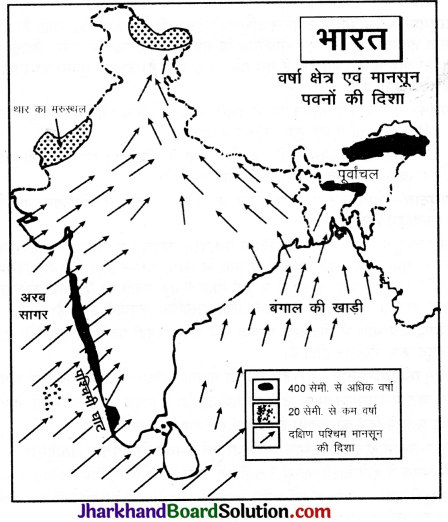
परियोजना कार्य
प्रश्न 1.
पता लगाइए कि आपके क्षेत्र में एक विशेष मौसम से कौन-से गाने, नृत्य, पर्व एवं भोजन सम्बन्धित हैं? क्या भारत के दूसरे क्षेत्रों से इनमें कुछ समानता है?
उत्तर:
विद्यार्थी अपने क्षेत्र के अनुसार इस प्रश्न को शिक्षक की सहायता से हल करें।
प्रश्न 2.
भारत के विभिन्न क्षेत्रों के विशेष ग्रामीण मकानों तथा लोगों की वेशभूषा के फोटोग्राफ इकडे कीजिए। देखिए क्या उनमें और उन क्षेत्रों की जलवायु की दशाओं तथा उच्चावच में कोई सम्बन्ध है।
उत्तर:
इस कार्य को विद्यार्थी शिक्षक की सहायता से स्वयं करें।
स्वयं करने के लिए
प्रश्न 1.
सारिणी-1 में दस प्रतिनिधि स्थानों के औसत माध्य, मासिक तापमान तथा औसत मासिक वार्षिक वर्षा दिया गया है। इसका अध्ययन करके प्रत्येक स्थान के तापमान और वर्षा के आरेख बनाइए।
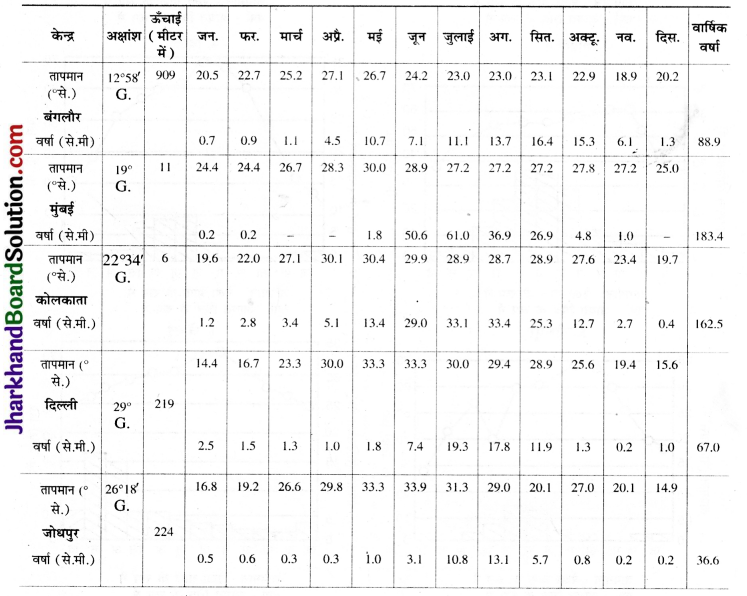
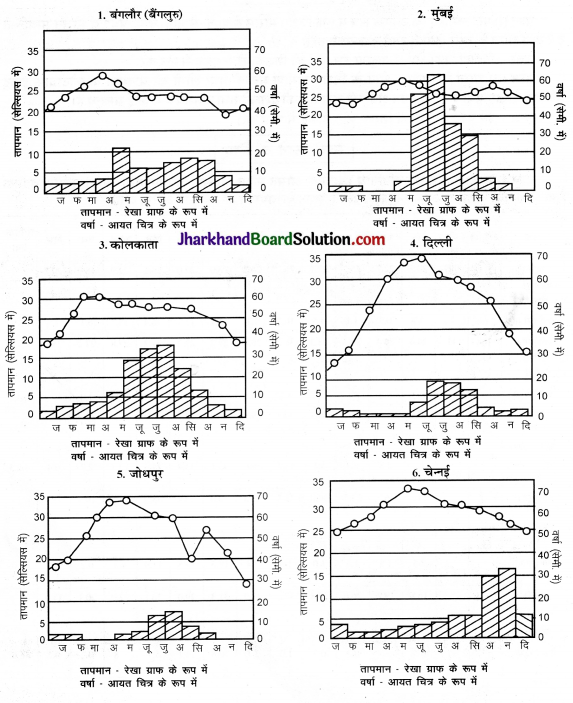
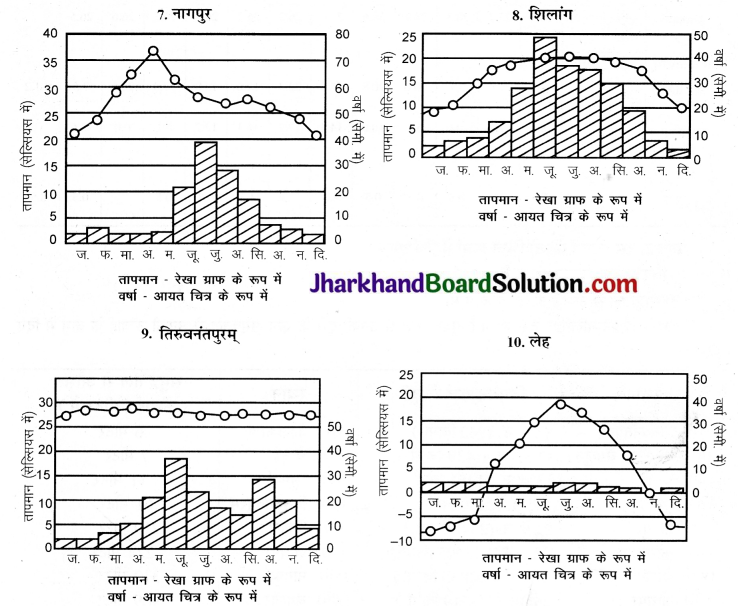
प्रश्न 2.
दस स्थानों को दो भिन्न क्रमों में लिखिए:
1. विषुवत् वृत्त से उनकी दूरी के क्रम में।
2. समुद्रतल से उनकी ऊँचाई के क्रम में।
उत्तर:
(i) निम्नलिखित दस स्थान विषुवत् वृन्त से उनकी दूरी के क्रम समुद्रतल से उनकी ऊँचाई के क्रम में दिए गए हैं
| स्थान | विषुवत् वृत्त से दूरी | स्थान | समुद्र तल से औसत ऊँचाई (मीटर में) |
| (i) तिरुवनंतपुरम् | 8°29 उ. (942 किमी.) | (i) कोलकाता | 6 मीटर |
| (ii) बंगलौर (बैंगलुरु) | 12° 58 उ. (1439 किमी.) | (ii) चेन्नई | 7. मीटर |
| (iii) चेन्नई | 13° 4 उ. (1451 किमी.) | (iii) मुम्बई | 11 मीटर |
| (iv) मुम्बई | 19°उ. (2100 किमी.) | (iv) तिरुवनंतपुरम | 61 मीटर |
| (v) नागपुर | 21° 9 उ. (2348 किमी.) | (v) दिल्ली | 219 मीटर |
| (vi) कोलकाता | 22° 34 उ. (2505 किमी.) | (vi) जोधपुर | 224 मीटर |
| (vii) शिलांग | 24°34 उ. (2835 किमी.) | (vii) नागपुर | 312 मीटर |
| (viii) जोधपुर | 26°18 उ. (2919 किमी.) | (viii) बंगलौर (बैंगलुरु) | 909 मीटर |
| (ix) दिल्ली | 29°उ. (3219 किमी.) | (ix) शिलाँग | 1461 मीटर |
| (x) लेंह | 34°उ. (3774 किमी.) | (x) लेह | 3506 मीटर |
प्रश्न 3.
1. सर्वाधिक वर्षा वाले दो स्थान।
उत्तर:
शिलाँग, मुम्बई।
2. दो शुष्कतम् स्थान।
उत्तर:
लेह, जोधपुर।
3. सर्वाधिक समान जलवायु वाले दो स्थान।
उत्तर:
मुम्बई, तिरुवनंतपुरम्।
4. जलवायु में अत्यधिक अन्तर वाले दो स्थान।
उत्तर:
दिल्ली, जोधपुर।
5. दक्षिण-पश्चिमी मानसून की अरब सागर शाखा के द्वारा सर्वाधिक प्रभावित दो स्थान।
उत्तर:
मुम्बई, बैंगलुरु।
6. दक्षिण-पश्चिमी मानसून की बंगाल की खाड़ी शाखा द्वारा सर्वाधिक प्रभावित दो स्थान।
उत्तर:
शिलाँग, कोलकाता।
7. दोनों से प्रभावित दो स्थान।
उत्तर:
तिरुवनंतपुरम्, कन्याकुमारी।
8. लौटती हुई तथा उत्तर-पूर्वी मानसून से प्रभावित दो स्थान।
उत्तर:
चेन्नई, आन्ध्र प्रदेश के तटीय क्षेत्र।
9. पश्चिमी विक्षोभों के द्वारा शीत ऋतु में वर्षा प्राप्त करने वाले दो स्थान।
उत्तर:
दिल्ली, लेह (हिमपात के रूप में)।
10. सम्पूर्ण भारत में सर्वाधिक वर्षा वाले दो महीने।
उत्तर:
जुलाई, अगस्त।
11. निम्नलिखित महीनों में सर्वाधिक गर्म दो महीने: फरवरी, अप्रैल, मई, जून।
उत्तर:
मई एवं, जून।

प्रश्न 4.
अब ज्ञात कीजिए:
1. तिरुवनंतपुरम् तथा शिलांग में जुलाई की अपेक्षा जून में अधिक वर्षा क्यों होती है?
उत्तर:
तिरुवनंतपुरम् केरल राज्य में भारत के दक्षिणी सिरे पर स्थित है। मानसून भारत में जून के महीने में दक्षिण की ओर से प्रवेश करता है जिससे तिरुवनंतपुरम् में पर्याप्त वर्षा होती है। मानसून की बंगाल की खाड़ी वाली शाखा के रास्ते में सबसे पहले शिलाँग की पहाड़ियाँ आती हैं जिनसे ये आर्द्र पवनें टकराकर वर्षा करती हैं। मानसूनी पवनों के मार्ग में सबसे पहले पड़ने के कारण तिरुवनंतपुरम् एवं शिलांग जुलाई की अपेक्षा जून में अधिक वर्षा प्राप्त करते हैं।
2. जुलाई में तिरुवनंतपुरम् की अपेक्षा मुम्बई में अधिक वर्षा क्यों होती है?
उत्तर:
जुलाई में मानसूनी हवाएँ देश के आन्तरिक भागों में पहुँच जाती हैं जिसके कारण तिरुवनंतपुरम् में वर्षा होती जबकि मुम्बई में अरब सागर की ओर से आने वाली मानसूनी पवनें जून के दूसरे सप्ताह में यहाँ पहुँचती हैं और इसके पश्चात् पश्चिमी घाट से टकराकर इस क्षेत्र में वर्षा करती हैं। यही कारण है कि जुलाई में तिरुवनंतपुरम् की अपेक्षा मुम्बई में अधिक वर्षा होती है।
3. चेन्नई में दक्षिण-पश्चिमी मानसन के द्वारा कम वर्षा क्यों होती है?
उत्तर:
दक्षिणी-पश्चिमी मानसून की अरब सागरीय शाखा पश्चिमी घाट के पश्चिमी भागों में अधिक वर्षा करती हैं। पश्चिमी घाट को पार करने पर इन पवनों में आर्द्रता की कमी आ जाती है। पवनों के नीचे उतरने से उनका तापमान बढ़ जाता है तथा उनमें शुष्कता बढ़ जाती है। इस तरह चेन्नई वृष्टिछाया क्षेत्र में आ आता है। फलस्वरूप चेन्नई में दक्षिण-पश्चिमी मानसून के द्वारा बहुत कम वर्षा होती है।
4. शिलाँग में कोलकाता की अपेक्षा अधिक वर्षा क्यों होती है?
उत्तर:
शिलाँग, मेघालय के पर्वतीय क्षेत्र में स्थित है पर्वतों से घिरे होने के कारण यहाँ संघनन प्रक्रिया तीव्र होती है और पवनें भारी वर्षा करने को विवश होती हैं, जबकि कोलकाता मैदानी भाग में स्थित है। यहाँ ऐसा कोई पर्वत या पहाड़ियाँ नहीं हैं जो मानसूनी पवनों को घेरने में सक्षम हों इसलिए यहाँ कम वर्षा होती है।
5. कोलकाता में जुलाई में जून से अधिक वर्षा क्यों होती है? इसके विपरीत, शिलाँग में जून में जुलाई से अधिक वर्षा क्यों होती है?
उत्तर:
जून के महीने में बंगाल की खाड़ी की ओर से मानसून पवनें, जो आर्द्रता से भरी होती हैं, जब उत्तरी-पूर्वी भाग से भारत में प्रवेश करती हैं तो वहाँ स्थित गारो, खासी, जयंतिया पहाड़ियों से टकराकर भारी वर्षा करती हैं। इन्हीं पहाड़ियों के मध्य शिलाँग स्थित है, जिससे यहाँ जून में अधिक वर्षा होती है। यहाँ से धीरे-धीरे ये मानसूनी पवनें पश्चिम दिशा की ओर बढ़ती हैं और जुलाई में कोलकाता में वर्षा करती हैं। इस प्रकार जून में कोलकाता में मानसून पूरी तरह नहीं पहुँच पाता है, जबकि शिलाँग में पहुँच जाता है। यही कारण है कि कोलकाता में जुलाई में जून से अधिक वर्षा होती है एवं इसके विपरीत शिलाँग में जून में जुलाई से अधिक वर्षा होती है।
6. दिल्ली में जोधपुर से अधिक वर्षा क्यों होती है?
उत्तर:
बंगाल की खाड़ी की ओर से आने वाली दक्षिणी-पश्चिमी मानसूनी पवनें जब भारत के उत्तरी-पूर्वी भाग में हिमालय पर्वतीय क्षेत्र की पहाड़ियों से टकराकर वर्षा करती हैं। इसके बाद ये पवनें पश्चिम की ओर बहना प्रारम्भ कर देती हैं तथा भारत के उत्तरी मैदानों में वर्षा करती हैं। दिल्ली भी इन्हीं मैदानी भागों में स्थित है जिससे दिल्ली में भी इन्हीं पवनों से वर्षा होती है। इसके विपरीत जोधपुर राजस्थान के पश्चिमी भाग में स्थित है
इस क्षेत्र में मानसून की अरब सागरीय शाखा के समानान्तर ही अरावली पर्वत स्थित है जिससे यहाँ पवनें बिना वर्षा किये आगे निकल जाती हैं। इसके अतिरिक्त बंगाल की खाड़ी की मानसूनी शाखा यहाँ पहुँचते-पहुँचते अपनी आर्द्रता समाप्त कर चुकी होती हैं इसलिए इन पवनों से यहाँ नाममात्र की वर्षा होती है। यही कारण है कि दिल्ली में जोधपुर की अपेक्षा अधिक वर्षा होती है।

प्रश्न 5.
1. अब सोचिए ! ऐसा क्यों होता है तिरुवनंतपुरम् की जलवायु सम है।
उत्तर:
समुद्र तटीय स्थानों की जलवायु सम होती है। जल अपना समकारी प्रभाव थल पर छोड़ता है। अतः समुद्र तटीय क्षेत्र ग्रीष्म ऋतु में न अधिक गर्म और न शीत ऋतु में अधिक ठण्डे होते हैं इसके अतिरिक्त समुद्र तटवर्ती क्षेत्रों का दैनिक तथा वार्षिक ताप परिसर दोनों ही कम होते हैं। यही कारण है कि तिरुवनंतपुरम् की जलवायु सम है।
2. देश के अधिकतर भागों में मानसूनी वर्षा के समाप्त होने के बाद ही चेन्नई में अधिक वर्षा होती है।
उत्तर:
देश के अधिकतर भागों में वर्षा दक्षिण-पश्चिम मानसूनी पवनों से होती है। सितम्बर-अक्टूबर माह में मानसूनी पवनें लौटना प्रारम्भ कर देती हैं। इस समय समस्त भारत में उत्तरी-पूर्वी पवनें चलने लगती हैं ये मानसूनी पवनें बंगाल की खाड़ी के ऊपर से गुजरते समय आर्द्रता ग्रहण कर लेती हैं और संघनित होकर चेन्नई में अधिक वर्षा करती हैं।
3. जोधपुर की जलवायु उष्ण मरुस्थलीय है।
उत्तर:
जोधपुर की जलवायु के उष्ण मरुस्थलीय होने के निम्नलिखित कारण हैं:
- यहाँ मानसूनी पवनें पहुँचते-पहुँचते शुष्क हो जाती हैं और वर्षा बहुत कम होती है।
- यहाँ तापमान उच्च रहता है जो वायु की आर्द्रता को वाष्पीकृत कर वर्षा के लिए बाधक बनता है।
- यहाँ बलुई मिट्टी पायी जाती है जो वर्षा के जल को तुरन्त सोख लेती है।
- यहाँ वार्षिक एवं दैनिक तापान्तर अधिक पाया जाता है।
- यहाँ वनस्पति का अभाव पाया जाता है।
4. लेह में लगभग पूरे वर्ष मध्य वर्षण होता है।
उत्तर:
जम्मू: कश्मीर का लेह क्षेत्र अत्यधिक ऊँचाई पर स्थित है जिसके कारण यहाँ वृष्टि का केवल हिमरूप ही दिखाई पड़ता है। यहाँ का न्यून तापक्रम भी जल को जमा देता है जिससे लेह में लगभग पूरे वर्ष मध्य वर्षण होता है।
5. दिल्ली और जोधपुर में अधिकतर वर्षा लगभग तीन महीनों में होती है, लेकिन तिरुवनंतपुरम् और शिलाँग में वर्ष के 9 महीने तक वर्षा होती है।
उत्तर:
दिल्ली और जोधपुर देश के आन्तरिक भागों में स्थित हैं, यहाँ मानसूनी पवनें बहुत देरी से पहुँचती हैं तथा सबसे पहले लौट भी जाती हैं, जबकि तिरुवनंतपुरम् और शिलांग में मानसूनी पवनें सबसे पहले पहुँचकर वर्षा करती हैं और सबसे बाद में लौटती हैं।
6. गम्भीरता से विचार कीजिए कि इन सब तथ्यों के बावजूद क्या हमारे पास इस निष्कर्ष पर पहुँचने के लिए पुष्ट प्रमाण है कि पूरे देश में जलवायु की सामान्य एकता बनाए रखने में मानसून का अत्यधिक महत्वपूर्ण योगदान
उत्तर:
यह तथ्य पूर्णरूपेण सत्य है कि पूरे देश में जलवायु की सामान्य एकरूपता बनाए रखने में मानसून का अत्यधिक महत्वपूर्ण योगदान है जो निम्नलिखित तथ्यों से स्पष्ट है
- पवन की दिशाओं का ऋतुओं के अनुसार परिवर्तन एवं उनसे सम्बन्धित ऋतुओं की दशाएँ ऋतु चक्रों को एक लय प्रदान करती हैं।
- सम्पूर्ण भारतीय परिदृश्य, इसके जीव-जन्तु एवं वनस्पति, इसका कृषि चक्र , मानवीय जीवन एवं उनके त्यौहार-उत्सव, सभी इसी मानसूनी लय के चारों तरफ घूमते हैं।
- मानसूनी पवनें हमें जल प्रदान कर कृषि की सम्पूर्ण प्रक्रिया में तीव्रता लाती हैं एवं सम्पूर्ण देश को एक सूत्र में बाँधती हैं।
![]()
![]()
![]()
![]()




